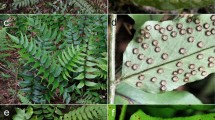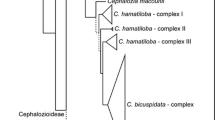Abstract
Cyrtomium is an Asiatic genus characterized by anastomosing veins with included veinlets, and comprises about 40 species. We sequenced rbcL and trnL-F sequences of 19 species of Cyrtomium and eight species from related genera in order to elucidate a molecular phylogeny of the genus using maximum-parsimony methods. The phylogenetic trees did not agree with traditional classifications. Cyrtomium was resolved as paraphyletic, and a clade including subseries Balansana of Cyrtomium, Cyrtogonellum, Polystichum subacutidens and Cyrtomidictyum (the BCPC clade) and a second one containing Cyrtomium sensu stricto were monophyletic. The results also implied that: (1) C. uniseriale was synonymous with C. balansae; (2) C. falcatum was likely the female parent of C. devexiscapulae; and (3) based on the rbcL and trnL-F sequence data, C. nephrolepioides and C. grossum were the female parents of C. shingianum and C. chingianum, respectively, although other evidence is needed for the confirmation of this hypothesis.



Similar content being viewed by others
References
Ching RC (1936) On the Genus Cyrtomium. Pr Bull Chin Bot Soc 2:85–106
Ching RC (1938) A revision of the Chinese and Sikkim-Himalayan Dryopteris with reference to some species from neighbouring regions. Bull Fan Mem Inst Biol Bot Ser 8(5):275–334
Ching RC (1940) The studies of chinese ferns, xxxiii. Bull Fan Men Inst Biol Bot Ser 8(5):173–184
Christensen C (1930) The genus Cyrtomium. Am Fern J 20:41–52
Copeland EB (1947) Genera Filicum. Chronica Botanica, Waltham, Mass.
Doyle JJ, Doyle JL (1987) A rapid DNA isolation procedure for small quantities of fresh leaf tissue. Phytochem Bull 19:11–15
Eastwood A, Cronk QCB, Vogel JC, Hemp A, Gibby M (2004) Comparision of molecular and morphological data on St. Helena: Elaphoglossum. Plant Syst Evol 245:93–106
Felsenstein J (1985) Confidence limits on phylogenies: an approach using the bootstrap. Evolution 39:783–791
Hasebe M, Ito M, Kofuji R, Ueda K, Iwatsuki K (1993) Phylogenetic relationships of ferns deduced from rbcL gene sequences. J Mol Evol 37:476–482
Hasebe M, Omori T, Nakazawa M, Sano T, Kato M, Iwatsuki K (1994) RbcL gene sequences provide evidence for the evolutionary lineages of leptosporangiate ferns. Proc Natl Acad Sci USA 91:5730–5734
Hasebe M, Wolf PG, Pryer KM, Ueda K, Ito M, Sano R, Gastony GJ, Yokoyama J, Manhart JR, Murakami N, Crane EH, Haufler CH, Hauk WD (1995) Fern phylogeny based on rbcL nucleotide sequences. Am Fern J 85(4):134–181
Haufler CH, Ranker TA (1995) RbcL sequences provide phylogenetic insights among sister species of the fern genus Polypodium. Am Fern J 85(4):361–374
Hauk WD (1995) A molecular assessment of relationships among cryptic species of Botrychium subgenus Botrychium (Ophioglossaceae). Am Fern J 85(4):375–394
Hauk WD, Parks CR, Chase MW (2003) Phylogenetic studies of ophioglossaceae: evidence from rbcL plastid DNA sequences and morphology. Mol Phylog Evol 28:131–151
Hillis DM, Huelsenbeck JP (1992). Signal, noise, and reliability in molecular phylogenetic analyses. J Hered 83:189–195
Iwatsuki K (1995) Dryopteridaceae. In: Iwatsuki K, Yamazaki T, David E Boufford, Ohba H (eds) Flora of Japan, vol I. Pteridophyta and gymnospermae. Kodansha, pp121–124
Kramer KU (1990) Dryopteridaceae. In: Kubitzki K (ed) The families and Genera of vascular plants. In: Kramer KU, Green PS (eds) Pteridophytes and gymnosperms, vol 1. Springer, Berlin Heidelberg New York, pp101–144
Kung HS (2001) Dryopteridaceae (2) (in Chinese). In: Flora Reipublicae Popularis Sinicae Tomus 5(2). Science Press, Beijing
Kung HS, Wang PS (1997) New materials for the Cyrtomium C. Presl of China. Chin J Appl Environ Biol 3(1):23–25
Li JX (1984) New ferns from Shandong province. Bull Bot Res 4(2):142–146
Li CX, Lu SG, Yang Q (2004) Asian origin for Polystichum (Dryopteridaceae) based on rbcL sequences. Chin Sci Bull 49(9):874–878
Little DP, Barrington DS (2003) Major evolutionary events in the origin and diversification of the fern genus Polystichum (Dryopteridaceae). Am J Bot 90:508–514
Löve A, Löve D, Pichi Sermolli REG (1977) Cytotaxanomical Atlas of the Pteridophyta. J. Cramer, Vaduz
Lovis JD (1977) Evolutionary patterns and processes in ferns. Adv Bot Res 4:229–415
Lu JM, Cheng X (2003) Chromosome number of 10 species of Cyrtomium (Dryopteridaceae) (in Chinese, English abstract). Acta Bot Yunn 25(6):663–670
Manton I (1950) Problems of cytology and evolution in the Pteridophyta. Cambridge University Press, Cambridge
Matsumoto S (2003) Species ecological study on reproductive systems and speciation of Cyrtomium falcatum complex (Dryopteridaceae) in Japanese archipelago. Ann Tsukuba Bot Gard 22:1–141
Mitsuta S (1986) A preliminary report on reproductive type of Cyrtomium (Dryopteridaceae) (in Japanese). Acta Phytotax Geobot 37(4–6):117–122
Mitsuta S (1988) Distribution and reproduction types of genus Cyrtomium (Dryopteridaceae) in China (in Japanese). Sci Eng Rev Doshisha Univ 28(3–4):199–299
Molvray M, Kores PJ, Chase MW (1999). Phylogenetic relationships with Korthalsella (Viscaceae) based on nuclear ITS and plastid trnL-F sequence data. Am J Bot 86:249–260
Murakami N, Nogami S, Watanabe M, Iwatsuki K (1999) Phylogeny of Aspleniaceae inferred from rbcL nucleotide sequences. Am Fern J 89(4):232243
Nakaike T (1982) New flora of Japan: Pteridophyta (in Japanese). Shibundo, Tokyo
Presl C (1836) Tentamen pteridographiae, seu genera filicacearum praesertim juxta venarum decursum et distributionem exposita. Filiorum Theophili Haase, Prague
Pryer KM, Smith AR, Skog JE (1995) Phylogenetic relationships of extant ferns based on evidence from morphology and rbcL sequences. Am Fern J 85(4):205–282
Sano R, Takamiya M, Ito M, Kurita S, Hasebe M (2000). Phylogeny of the lady fern group, tribe Physematieae (Dryopteridaceae) based on chloroplast rbcL gene sequences. Mol Phylogen Evol 15:403–413
Shing KH (1965) A taxonomical study of the genus Cyrtomium Pr (in Chinese, English abstract). Acta Phytotax Sin I:1–48
Simmonds MP, Ochoterena H (2000) Gaps as characters in sequence-based phylogenetic analyses. Syst Biol 49:369–381
Swofford DL (2001) PAUP*. Phylogenetic analysis using parsimony (*and other methods), version 4. Sinauer, Sunderland, Mass.
Taberlet P, Gielly L, Pautou G, Bouvet J (1991) Universal primers for amplification of three non-coding regions of chloroplast DNA. Plant Mol Biol 17:1105–1109
Tagawa M (1934) A review of the genus Cyrtomium of Japan. Acta Phytotax Geobot 3(2):57–67
Tryon AF, Lugardon B (1991) Spores of the Pteridophyta: surface, wall structure, and diversity based on electron microscope studies. Springer, Berlin Heidelberg New York
Tryon MR, Tryon AF (1982) Ferns and allied plant: with special reference to tropical America. Spinger, Berlin Heidelberg New York
Tsai JL, Shieh WC (1975) Chromosome numbers of the family Aspidaceae (Sensu Copland) in Taiwan (1). J Sci Eng 12:321–334
Tsai JL, Shieh WC (1985) A cytotaxanomic survey of the fern family Aspidaceae (Sensu Copland) in Taiwan. J Sci Eng 22:121–144
Walker TG (1979) The cytogenetics of ferns. In: Dyer AF (ed) The experimental biology of ferns. Academic Press, London, pp 87–132
Wolf PG, Soltis PS, Soltis DE (1994) Phylogenetic relationships of dennstaedtioid fern: evidence from rbcL sequences. Mol Phylogen Evol 3(4):383–392
Wu SF (1997) A new species of Cyrtomium from Hunan. J Wuhan Bot Res 15(3):218–220
Wu SK, Mitsuta S (1985) Two new species of cyrtomioid ferns from limestone area of Yunnan. Acta Phytotax Geobot 36(1–3):22–26
Yatabe Y, Nishida H, Murakami N (1999) Phylogeny of Osmundaceae inferred from rbcL nucleotide sequences and comparison to the fossil evidences. J Plant Res 112:397–404
Yatskievych G, Stein DB, Gastony GJ (1988) Chloroplast DNA evolution and systematics of Phanerophlebia (Dryopteridaceae) and related genera. Proc Natl Acad Sci USA 85:2589–2593
Acknowledgements
We acknowledge the financial support of a grand for the construction of scientific and technological platform from the Chinese Ministry of Science and Technology (2004DKA30430). We would like to express our gratitude to Dr David S. Barrington of the University of Vermont, Burlington for providing Polystichum lonchitis and reference; Dr Ching-I Peng of the Institute of Botany, Academia Sinica, Taipei and Prof. Shu-Gang Lu of the University of Yunnan for providing Cyrtomium falcatum; and Ms Hong-Zhe Li of the Kunming Institute of Botany for providing C. yunnanense material. We also thank Prof. Pei-Shan Wang of the Institute of Biology, Academy of Guizhou for assistance during the field work.
Author information
Authors and Affiliations
Corresponding author
Rights and permissions
About this article
Cite this article
Lu, JM., Li, DZ., Gao, LM. et al. Paraphyly of Cyrtomium (Dryopteridaceae): evidence from rbcL and trnL-F sequence data. J Plant Res 118, 129–135 (2005). https://doi.org/10.1007/s10265-005-0201-y
Received:
Accepted:
Published:
Issue Date:
DOI: https://doi.org/10.1007/s10265-005-0201-y




